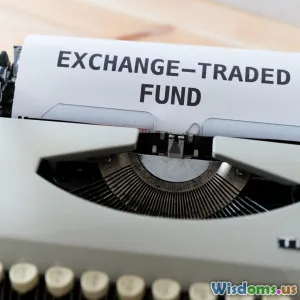
How to Build Wealth Using Small Cap ETFs
10 min read Unlock the potential of small cap ETFs to build lasting wealth with strategic insights and proven methods. (0 Reviews)
How to Build Wealth Using Small Cap ETFs
Building wealth through investing has many paths—but one increasingly popular route is small cap ETFs. Despite often flying under the radar, these funds can offer unique growth opportunities that many large cap stocks and broad index funds cannot. In this comprehensive guide, we’ll dive into what small cap ETFs are, why they matter, and exactly how you can strategically use them to build long-term wealth.
Introduction: Why Small Cap ETFs Deserve Your Attention
Imagine discovering a treasure chest buried deep beneath overlooked terrain. That's a fitting analogy for small cap investing. Small cap ETFs focus on companies with relatively small market capitalizations—typically between $300 million to $2 billion. These companies are often at early growth stages, innovating and expanding rapidly.
While large cap stocks get most headlines, small cap stocks historically offer higher returns over time due to their growth potential. However, their volatility and risk levels are often more pronounced. Using ETFs (exchange-traded funds) balances out the company-specific risks by providing diversification, all with the liquidity and transparency of regular stock trading.
If your goal is long-term wealth growth with a calibrated level of risk, understanding and leveraging small cap ETFs can be a game changer.
What Are Small Cap ETFs?
Defining Small Cap
Small cap companies generally have market capitalizations between $300 million and $2 billion. Unlike mega-cap giants like Apple or Microsoft, small cap firms are often younger, more nimble, and can disrupt markets or carve niche spaces rapidly.
What are ETFs?
ETFs are baskets of securities that trade like a stock. They track indexes, sectors, or themes, letting investors own a diversified portfolio with one purchase.
What Makes Small Cap ETFs Unique?
By focusing exclusively on small cap companies, these ETFs aim to capture that sweet spot in the market where growth potential is significant but individual stock risk remains substantial. Examples include:
- iShares Russell 2000 ETF (IWM): Tracks the Russell 2000, an index of about 2000 small cap U.S. stocks.
- Vanguard Small-Cap ETF (VB): Uses a broad-based index covering the small cap universe.
- Schwab U.S. Small-Cap ETF (SCHA): Known for a low expense fee and broad exposure.
Each ETF has unique index methodologies, sector weightings, and expense ratios, which we will discuss further.
Why Invest in Small Cap ETFs?
Higher Return Potential
Historically, small cap stocks have outperformed large caps over long periods. According to research from Ibbotson Associates, from 1926 to 2020, small cap stocks delivered annualized average returns of approximately 12%, versus about 10% by large cap stocks. Although volatility and downturns can be more severe, the growth upside is compelling.
Diversification Benefits
Adding small cappers can reduce portfolio correlation with large caps. For example, during the 2008 financial crisis, some small cap segments rebounded quicker in subsequent years, boosting portfolio resilience.
Exploiting Market Inefficiencies
Smaller companies are less followed by Wall Street analysts, so mispricings are more common. Investors who identify quality small caps early stand to gain outsized returns.
Accessibility and Cost Efficiency via ETFs
Direct individual small cap stock investments are risky, requiring extensive research. ETFs pool hundreds or thousands of such companies, mitigating single-stock risk while charging low management fees.
How to Incorporate Small Cap ETFs into Your Wealth Building Strategy
1. Define Your Investment Horizon and Risk Tolerance
Small cap ETFs are best suited for investors with a medium- to long-term horizon (5-10+ years) who can tolerate volatility.
Example: Jane, a 35-year-old professional, allocates 20% of her equity portfolio to small cap ETFs, knowing swings of 20-30% won’t disturb her retirement planning.
2. Choose the Right ETFs with a Strategic Approach
Consider factors like:
- Expense Ratios: Lower fees boost net returns over time.
- Index Construction: Some indices are market cap weighted; others are equal weighted, favoring smaller firms within the small cap scene.
- Liquidity: Big funds like IWM offer tight spreads and easy trading.
3. Balance Between Broad Exposure and Thematic Plays
While broad ETFs cover thousands of companies, thematic small cap ETFs focus on sectors like tech or healthcare startups which can offer higher rewards but increased sector risk.
4. Practice Dollar-Cost Averaging
Invest consistently over time regardless of market conditions to smooth purchase prices. For example, investing $500 monthly into small cap ETFs during both bull and bear markets capitalizes on market fluctuations without trying to time the market.
5. Rebalance Periodically
Small cap ETFs might outpace other assets, skewing your portfolio’s risk profile. Rebalancing maintains allocation discipline, locking in gains and controlling risk.
Real-World Examples and Data Insights
Case Study: IWM Performance
Since its inception in 2000, IWM has delivered an average annual return of roughly 9-10%, outperforming many large cap peers. During bull markets, returns can soar, but during market corrections, the volatility proves noticeable. For instance, during the 2020 COVID-19 crash, IWM dropped about 40%, but rebounded spectacularly with gains exceeding 70% over the next year.
Expert Quote
Jeremy Siegel, Professor of Finance at Wharton School, writes in Stocks for the Long Run: "Small-cap stocks offer higher beta—hence risk—but are rewarded with higher average returns, making them worthwhile for investors with an appetite for growth."
Sector Allocation Insights
Small cap ETFs tend to be overweight industrials, consumer discretionary, and information technology sectors. This provides an additional tactical angle for investors bullish on economic growth and innovation cycles.
Risks to Consider and How to Mitigate Them
Volatility and Drawdowns
Small caps face larger swings; the Russell 2000's standard deviation often exceeds 20%, vs. ~15% for large cap indexes.
Less Liquidity and Higher Bid-Ask Spreads
Smaller companies and some ETFs may have wider spreads, increasing trading costs.
Economic Sensitivity
Smaller firms depend more heavily on domestic economic conditions and often have less diversified revenue streams.
Mitigation Strategies
- Use well-established ETFs with high liquidity.
- Diversify by complementing small caps with mid and large caps.
- Maintain long-term investing discipline amid shocks.
Conclusion: Seizing Opportunities with Small Cap ETFs
Small cap ETFs offer a compelling path for investors aiming to build wealth consistently over time by harnessing the growth engine of smaller public companies without the concentration risks of individual stocks. When applied thoughtfully—through careful ETF selection, portfolio balance, and persistent investing—small cap ETFs can substantially enhance portfolio returns.
Whether you’re a seasoned investor or just building your portfolio, incorporating small cap ETFs aligns you with an asset class poised for innovation-driven growth. The key lies in understanding their unique traits, risks, and how they can fit your personal investment goals.
Start with your preferred broker, identify high-quality small cap ETFs, commit to a disciplined investment plan, and watch how the dynamic world of smaller companies can fuel your journey to financial prosperity.
References
- Ibbotson Associates — Historical Stock Return Data
- Jeremy Siegel, Stocks for the Long Run (5th Edition)
- Morningstar ETF Analysis Reports
- Vanguard and BlackRock ETF Fact Sheets
- MarketWatch and Yahoo Finance Historical Data
Disclaimer: This article is for informational purposes only and does not constitute financial advice. Always consult a financial advisor before making investment decisions.
Rate the Post
User Reviews
Popular Posts




















